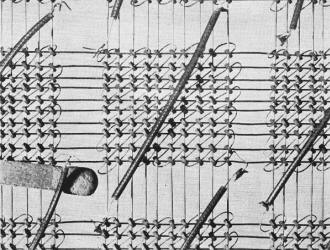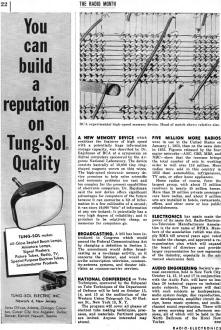|
October 1953 Radio-Electronics
 [Table of Contents] [Table of Contents]
Wax nostalgic about and learn from the history of early electronics.
See articles from Radio-Electronics,
published 1930-1988. All copyrights hereby acknowledged.
|
Radio-Electronics
magazine ran a regular industry news column entitled "The Radio Month." The headline
item in the December 1949 issue was the emergence of a new type of digital memory
device using nearly microscopic magnetic toroidal coils with a matrix of even tinier
wires threaded through them in order to write and read 1's and 0's. RCA (Radio
Corporation of America) created
this 10,000-bit magnetic core memory assembly in order to overcome the size and speed limitations
of alternate methods available in the day - primarily mercury-based delay lines.
UNIVAC II, commissioned
in 1958, was the first major digital electronic computer to use this magnetic core
memory, but given that transistor development was still in its infancy, vacuum tubes
were used to address this new high tech memory.
Another notable news item reported on the vastly growing number of radio sets
sold in the previous year timespan. That was somewhat unexpected since many market
predictions had been suggesting the emergence of cheaper television sets would cause
a drop in demand for radios. It obviously didn't happen that way.
A New Memory Device
 RCA
experimental high-speed memory device. Head of match shows relative size. RCA
experimental high-speed memory device. Head of match shows relative size.
A new memory device which combines the features of high speed with a potentially
huge information storage capacity, was described by Dr. Rajchman of RCA at a symposium
on digital computers sponsored by the Argonne National Laboratory. The device consists
basically of 10,000 tiny ring-shaped magnets woven on thin wires. The high-speed
electronic memory device promises to help solve scientific and economic problems
too vast and too complex for the present capabilities of electronic computers. Dr.
Rajchman said the new device offers significant advantages for computers of the
future because it can memorize a bit of information in a few millionths of a second;
it can store 10,000 "bits" of information at anyone instant; it potentially has
a very high degree of reliability; and it promises to be relatively cheap, as memories
for computers go.

BROADCASTING. A bill has been introduced in Congress which would
amend the Federal Communications Act by changing a definition in Section 3. The
amendment would define broadcasting as a no-charge activity, as it concerns the
listener, and would describe subscription television, community-antenna systems,
and theater television as common-carrier services.
NATIONAL CONFERENCE on Tube Techniques, sponsored by the Sub
panel on Tube Techniques of the Department of Defense will be held on October 13,
14, and 15 at the auditorium of the Western Union Telegraph Co., 60 Hudson St.,
New York 13, N. Y.
The program will cover all phases of electron tube making techniques, processes,
and materials. Pertinent papers are invited. Anyone interested may attend.
FIVE MILLION MORE RADIOS were in use in the United States on
January 1, 1953, than on the same date in 1952. Figures released by the four major
networks - ABC, CBS, MBS, and NBC - show that the increase brings the total number
of sets in working order to well over 110 million. More radios were sold in this
country in 1952 than automobiles, refrigerators, TV sets, or other home appliances.
Home radios of course, form the largest group, with about 75 million receivers
in nearly 45 million homes. More than 26 million private passenger cars have radios,
and about 9 million sets are installed in hotels, restaurants, offices, and other
more or less public establishments. RCA experimental high-speed memory device. Head
of match shows relative size. ELECTRONICS has again made the power of its name felt.
Radio-Electronics-Television Manufacturers Association is the new name of RTMA.
Members of the association (which was simply RMA till several years ago) voted to
make the change, and approved a re-organization plan which will expand the board
of "directors and provide larger representation for new segments of the industry,
especially in the advanced electronics field.
AUDIO ENGINEERING Society's annual convention, held in New York
City October 14, 15, 16 and 17 in conjunction with the Audio Fair, will have no
less than 26 technical papers on technical audio subjects. The papers will deal
with such subjects as loudspeakers, audio system design, disc reproduction, new
developments, amplifier" circuit design, home music systems, and multichannel sound
reproduction. There will be seven morning and afternoon sessions, all of which will
be held in the North Ballroom of the Hotel New Yorker.
END
Posted October 22, 2020
|






























